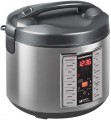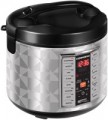The rated power of a multicooker determines the speed at which it heats up when cooking. Manufacturers usually choose a power level that ensures efficient heating of the working capacity for its intended purpose. However, models of the same size and similar features can vary in terms of power. It's important to consider that a more powerful multicooker is generally more advanced and efficient, allowing for additional features like frying or baking. On the downside, higher power consumption is typically associated with higher costs.
Speaking about energy consumption, it is worth saying that it is relatively small in household multicookers —
from 750 to 1000 W for most models. Devices
with more than 1000 W are rare, relatively low power options are more common —
500 – 750 W and even
less than 500 W.
The type of non-stick coating used in the working container of the multicooker.
—
Teflon. Teflon, also known as polytetrafluoroethylene (PTFE), is a widely used non-stick coating characterized by its dark color. It offers excellent non-stick properties and is easy to clean, making it popular in various applications. However, there are specific guidelines for using Teflon. Overheating should be avoided as it can cause cracks and the release of harmful substances. Although the maximum operating temperature of Teflon is sufficient for frying, it is not extremely high. Scratches can render the coating unusable and can also lead to the release of harmful substances, so Teflon should be washed carefully, and only wooden or silicone spatulas should be used, avoiding metal utensils.
—
Ceramic. Ceramic coating offers a combination of safety and reliability. It is resistant to scratches and remains usable even if scratches occur, without releasing any harmful substances. Similarly, ceramic coatings can withstand high temperatures without deteriorating or emitting harmful fumes. Cleaning ceramic-coated containers is relatively easy and straightforward. However, it's worth noting that ceramic coatings are more sensitive to shocks and temperature changes, which can lead to cracking or even chipping of the coating.

